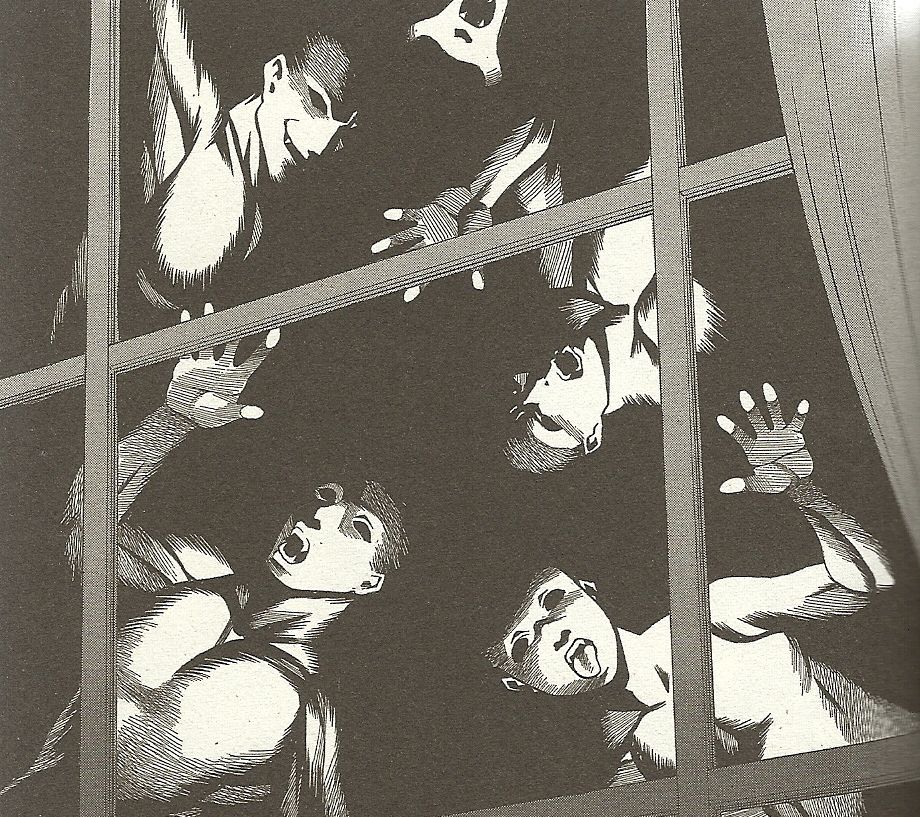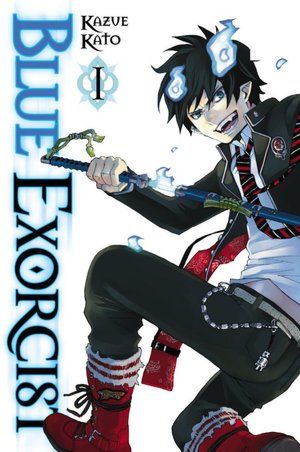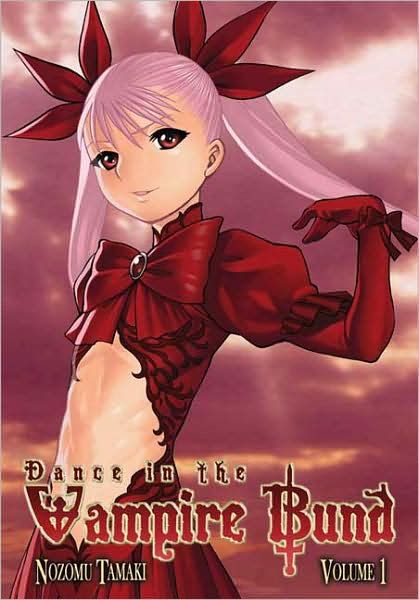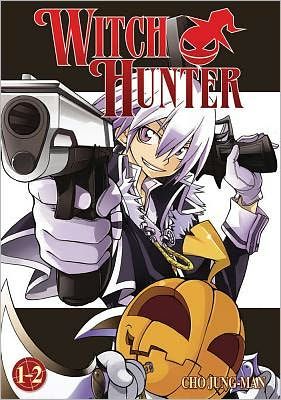In the past few months I've sampled a bunch of new manga series, and a noticed a common theme in a handful of them. While they weren't at all what one could safely call horror comics, they all took elements from the horror genre—the monsters and other supernatural entities, specifically—and repurposed them into different types of narratives. Of the four discussed below, three are action/comedy narratives revolving around the supernatural, while another is more of a romance/political thriller with traditional Halloween "characters" like werewolves and vampires.
None of these series are brand-new, but rather are new to me and, given the focus of Robot 6, I'm assuming new to a lot of primarily super-comics readers who aren't super manga-literate. Which is simply my way of saying don't hate, Manga-Savvy Readers, I know you probably know all about all these already, and, Not Manga-Savvy Readers? Here are some manga series you might like to try.
They are all at different points in their U.S. publication and serialization, so, for the purposes of this article, I'm only going to discuss the first two volumes of each series. So join me after the jump for brief reviews of Blue Exorcist, Dance in the Vampire Bund, Soul Eater and Witch Hunter.
Blue Exorcist, by Kazue Kato
Supernatural entities: Demons, Satan
Born of a union between a mortal woman and Satan, a half-breed heir to the throne of Hell decides to devote his life to combating his evil father, working as an exorcist and supernatural warrior on the behalf of humanity. Blue Exorcist is, in other words, basically Marvel's 1970s Son of Satan retold as a hip manga, with elements of private-school melodrama and comedy thrown in.
Well, at least in the broadest sketches. Here, Satan's son is teenager Rin, who, with his orphaned half-brother, was raised in a Catholic monastery by a friendly priest. When Rin's real father appears and tries to take him home to Hell, the priest gives his life defending Rin, but the cat's out of the bat, and he finally knows who he really is and what powers he has.
He is adopted by flamboyant Sir Mephisto Pheles (get it?), whose goth-clown wardrobe belies his day job as the president of a huge and prestigious school that also houses a secret school for warrior exorcists, which both Rin and his brother are enrolled in.
Over the course of the first two volumes, Kato introduces us to these main characters and a small cast consisting of their classmates, while constantly hinting that mysterious forces are at work within the school, and that Sir Pheles might not be as good a guy as he seems.
Kato's style is thin-lined and occasionally sketchy, particularly during action scenes, and the design sensibility strong and detailed. The demons the kids encounter, mostly in a school setting, are pretty scary and unique-looking, with our hero Rin being the closest thing to a traditional, western-looking demon (pointy ears, tail, horns, flames), but even his demonic signifiers are hardly generic.
Dance in the Vampire Bund, by Nozomu Tamaki
Supernatural entities: Vampires, Werewolves
Were I to take a trip that involved crossing an international border, say, to drive into Canada for a weekend, this would be one of the last comics I would consider taking as reading material. There's a pretty fair amount of nudity, as vampire attacks in this book generally involve the shredding of the female victims' tops, and the administration of mouths, fangs and claws to places other than the neck, but the most uncomfortable aspect is how often Mina Tepes, centuries-old queen of all vampires, is in a state of undress, and how shamelessly she flirts with teenage protagonist Akira.
See, Mina may be hundreds of years old, but she has the body of a pre-pubescent kid, as I guess that's the point in her human life when she became a vampire. So probably not the book for any of the still remarkably many "civilians" who think there's something weird and perverted about manga in general. (By the climax of the second volume, it's revealed that "vampires are creatures whose very form is ruled by their minds ... everyone possesses a true form which reflects their inner spirit." Mina's true form is that of a full-grown, adult woman — also often scantily clad — but who wants to have that conversation with a border guard?)
That aspect of the book is probably one that a lot of folks will have a hard time getting past, and that is perhaps how it should be (Looking back at the creepiest scenes in the first volume, it seems like they could quite easily be drawn in a way similar to the way Ken Akamatsu handled teen nudity in his Love Hina and Negima without losing anything important to the story, just unnecessary detail).
The plot is intriguing though. The long-secret diaspora of vampires want their own nation and to "come out" and formally join the world (Something that several superhero comics and a few movies have dealt with in the past). They do so in the most politically viable way: By paying of Japan's entire national debt and procuring a small island off the coast of Japan, referred to as The Bund.
The first two volumes are split between the political intrigue of this move and factions of the vampire and human governments vociferously disagreeing with the decisions of Tepes, leading to assassination attempts and terrorism and acts of political sabotage. Meanwhile, Akira, a werewolf of the Earth Clan, is forced to fulfill his childhood pledge (and familial duty) to serve as Mina's bodyguard, though there's also an element of uncomfortable, forbidden romance between the two.
The fact that Akria is a werewolf is played rather coyly throughout these first two volumes, with him not fully revealing his true form until the climax of the second volume ... during the battle in which Mina reveals her true form as a grown woman.
Soul Eater, by Atsushi Ohkubo
Supernatural entities: Witches, The Grim Reaper, Mummies, a Zombie
If we don't count straight comedy series like the incomparable Yotsuba&!, this might be my favorite manga series at the moment, boasting as it does an appealing mix of over-the-top action and fight sequences, funny one-trait-apiece characters, particularly savvy character designs often applied to a type of pop culture redesign, a pretty unique premise and a particularly, artificially artsy setting.
The premise? Shinigama-San, whom we'd call the Grim Reaper, has founded a school called Death Weapon Meister Academy, in which teams of students seek to create weapons for Death himself, these weapons "graduating" once they've taken the souls of a 100 evil men (souls in this are glowing orbs that look a bit like Pac-Man power pellets on fire) and the soul of a witch.
The students who wield the weapons are called "meisters," and some of the students are also weapons who shift between human and weapon form. Our title character is the hunched-over, usually drooling Soul, who is the scythe of uptight but talented school girl Maka. In the first two volumes, we meet their fellow students Black Star, a boastful would-be assassin whose self-promoting personality will probably remind certain superhero-savvy readers of Booster Gold and his weapon, Tsubaki, who can transform into a whole arsenal's worth of ninja weapons, as well as Death The Kid, Shinigami-san's perfectly human-looking son whose talent for taking lives is only matched by his crippling obsessive-compulsive disorder revolving around symmetry, and his weapons, a pair of cheerful girls named the Thompsons who can turn into pistols.
The first volume introduces us to the three teams individually, as Maka and Soul attempt to kill their witch, Black Star and Tsubaki an American gangster stereotype Don Capone, and The Kid and the Thompsons as they visit a mummy-filled pyramid.
By the second volume, a plot involving an infiltration of the school by witches and the emergence of a rival type of weapon to the, um, "good" death weapons at the school begin to kick in.
The character designs are all incredibly strong, and Ohkubo bases a lot of them on pre-existing characters or concepts, sometimes it's no more than a verbal joke, like the first witch we meet being named Blair, but other times it's much more elaborate, like Dr. Franken Stein, a handsome young doctor with a giant screw piercing his head, and a wardrobe consisting completely of clothing stitched together ... not unlike a monster a doctor with a similar name once made, a witch with snakey elements named Medusa and Bloodthirsty Killer Jack The Ripper, Phantom Thief Lupin and, perhaps my favorite design, Phantom Monk Rasputin.
The world the characters move in and through is highly abstracted; featuring a sun and moon that have faces and often react to the goings-on in the panels, and the streets and walls in the cities below them are full of roughly drawn, jagged lines with little to no pretense of being representational.
Witch Hunter, by Cho Jung-Man
Supernatural entities: Witches
Technically this is from Korea and thus manhwa, not manga, but why quibble over exact country of origin? It looks and reads like manga, and is collected and published in the same format as manga. The premise is pretty thoroughly explained in the two-word title and, unfortunately, the narrative doesn't get a whole hell of a lot deeper or more complex than that in the comic itself — at least not in these first two volumes.
In a world where witches have gone to war with humanity, decimating the population, a class of witch-fighting warriors called Witch Hunters have emerged to,um, hunt the witches. Our protagonist is Tasha Godspell, who has a rather personal investment in the war against witches (his little sister is one).
Like all Hunters, he has a variety of special equipment and magical weapons with which to prosecute his quest, and, not unlike the alchemists of Full Metal Alchemist, each hunter has a nickname relating to a special ability or weapon (That's not the only similarity to FMA; Cho's drawings of at least one kind of magical attack are identical to the way alchemists attack in FMA). Tasha is "The Marksman," and uses a variety of special magical handguns he stores in a sort of inter-dimensional bag of holding. He's aided in his quest by Halloween, a sentient jack o' lantern-headed marionette who fights at his side using special swords.
The entire first volume of the series is devoted to one big fight with a witch, who are here very powerful sorceresses with very elaborate funny hats. By the second volume, Tasha has allied with a few more hunters and meta few more witches, while scenes are often cut to involving a power struggle between several powerful witches Tasha has yet to meet.
The costuming is pretty cool, but there's not a whole lot to this beyond fighting so far, and much of what was there seemed derivative. It reminded me a lot of the plotting of the Dragon Ball Z-branded comics with a cosmetic layer of Full Metal Alchemist applied, but it lacked the humor and dramatic complexity of either of those superior comics. It's diverting, but nothing more.





